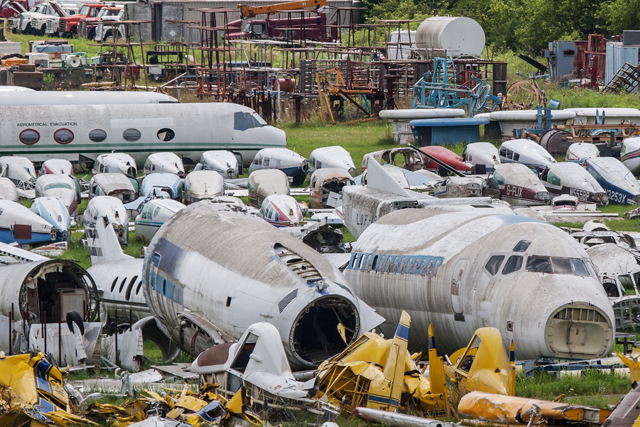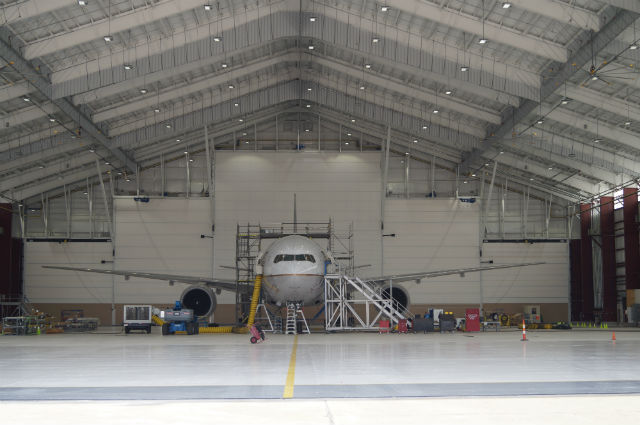In recent years, the North American MRO business has been relatively stable and predictable, growing modestly in line with carriers’ fleet plans while capturing incrementally more work from overseas operators, say experts.
But times may be changing.
Observers say that in addition to being increasingly squeezed by powerful OEMs, MRO providers risk being left behind by rapidly-developing technologies.
They urge MRO shops to invest in research and development, citing the need to keep pace with technologies like three-dimensional printing, predictive maintenance, aircraft health management and advanced mobile devices.
“Early indications are that MROs are continuing to cede ground to other industry participants,” Andrew Medland, a principal at consulting company Oliver Wyman, tells Flightglobal.
He points out that a recent industry survey confirms MRO shops tend to invest relatively little on research and development and tend to see themselves as slow to react to new technologies.
“MRO operators are not that quick to jump on new technologies,” says Medland.
The results of that survey have not yet been publicly released, the company says.
Meanwhile, the fuel price decline has left a bull’s eye on maintenance costs, which now account for a greater share of airlines’ costs, insiders note.
And airlines, most of which are now solidly in the black, finally have cash needed to invest in maintenance efficiencies, they add.
“You have this confluence of technology and money,” says Kevin Deal, vice president for aerospace and defense at software provider IFS North America. “You have a lot of things that are starting to happen.”
“Airline operators are not necessarily throwing that cash back to investors. They know they need to invest to make themselves more competitive,” Deal adds.

Large numbers of 757s, MD-80s and A320s will be retired in the next 10 years
AirTeamImages
TECHNOLOGY WAVE
Medland at Oliver Wyman says a coming “wave of disruptive technology” will make business as usual increasingly problematic for MROs.
Technological improvements in recent years have largely been led by aircraft and engine manufacturers, which collect data from sensors on the aircraft and engines they make, he notes.
“That is ceding a massive amount of advantage to one industry participant,” says Medland. “That data will create all sorts of insights.”
Armed with ever-increasing loads of data, OEMs are developing improved aircraft health management systems and predictive maintenance technologies, which can help carriers fix problems proactively, says Medland.
Three-dimensional printing – also known as additive manufacturing – is also maturing, and promises to help airlines and parts manufacturers more quickly design and produce improved components, experts say.
In addition, artificial intelligence systems may soon enter the mix, adds Medland.
Those developments should be a “call to arms” to MRO providers, says Medland.
“There is still some time to get a strategic grip on some of those technologies,” he says. “The next winners will out-innovate their competitors.”
Deal says MRO shops might consider investing in mobile or even “wearable” computers.
Technicians working on the flight line can use such devices to snap and send pictures to more senior (and more expensive) off-site technicians, who can help diagnose problems and determine fixes, Deal says.
The devices could even be worn on the wrist like a watch and have voice recognition technology. “If a person has two wrenches in their hands, it is tough to punch buttons,” Deal says.
The computers could also transmit simple notifications to technicians or provide specifications like torque settings, without overloading them with too much information.
“If that person knows, via the device in their hand, that something else is due in a day or two, why not affect that fix now?” Deal says.
STEADY GROWTH
Despite indications of being slow to adopt new technology, the North American civil MRO industry continues to grow at a pace observers describe as modest.
The business in North America will be worth some $20.1 billion this year but will dip slightly between now and 2020 before resuming growth and reaching $21.3 billion by 2025, a ten-year annual growth rate of 0.6%, according to a report released 18 March by the Aeronautical Repair Station Association and Cavok, a division of Oliver Wyman.
By comparison, the global MRO business will be worth $67.1 billion this year and increase about 4.1% annually, hitting $100 billion in 2025, the report says.

ARSA and Cavok Global Fleet & MRO Market Economic Assessment 2015-2015
The North American commercial fleet included about 7,300 aircraft in 2014 and will increase an estimated 0.6% annually to 7,942 aircraft by 2024, according to a 2014 MRO business planning study from consultancy Team SAI.
Between now and 2024, North American carriers will take delivery of an estimated 3,735 new aircraft, of which about 2,100 will be narrowbodies, about 474 will be widebodies and the remainder will be turboprops and regional jets, according to that report.
All those new aircraft will mean MRO providers will need to receive new certifications, and invest in new tools and training, it adds.
And new aircraft types will likely have longer maintenance intervals, meaning MRO shops may need to diversify or modify their businesses in response to periods of lower demand, says the report.
Meanwhile, over 10 years North American airlines will retire some 2,979 aircraft, including large numbers of Boeing 757s, MD-80s and Airbus A320s, the report predicts.
The health of the business has been reflected in recent months by US expansions.
AAR, based in Wood Dale, Illinois, is seeing “healthy activity” at its new facility in Lake Charles, Louisiana, which opened one-and-a-half years ago. About six weeks ago the company opened a new hangar at the site capable of housing an A380.
“Today, if you brought a widebody opportunity to me, the first slot I could offer you is in May,” AAR’s vice president of sales Troy Jonas tells Flightglobal. “We are busy right now.”
Jonas declines to name customers, but says they include “large domestic carriers” and Latin American airlines that operate types like 767s, 777s, A330s and A340s.
AAR also sees opportunity for business from airlines based in Southeast Asia, Jonas adds.
“We are very bullish on widebodies,” he says. “We expect demand and opportunity to increase.”

A widebody aircraft in a hangar at AAR's Lake Charles, Louisiana, MRO site, which the company opened in 2013
AAR
AAR is also developing a new MRO site at Chicago Rockford International airport in Illinois. and expects to open the facility sometime in 2016.
Demand has been healthy partly because labour costs in Asia have risen in recent years, while at the same time US MRO companies have “done a very admirable job” of improving efficiency, Jonas says.
That trend has benefitted the entire North American industry, having “slowed the multi-year pattern of sending aircraft overseas”, says a 2014 survey from Oliver Wyman.
“North American MROs have an opportunity to repatriate a large share of this widebody work over the coming decade,” adds TeamSAI’s report.
AAR’s Jonas says the MRO business has also benefitted because airlines have rushed to upgrade aircraft with newer interiors and modern in-flight entertainment systems.
Other companies have also expanded recently.
In February, rapidly-expanding US regional carrier Silver Airways announced it had nearly completed renovations on a 38,000ft² (3,530m²) MRO facility at Orlando International airport. Silver hopes to open the site by the end of March.
The airline will use the facility, a former Delta Air Lines and Comair site, to maintain its fleet of 26 Saab 340 turboprops.

Rendering of Silver's recently-renovated Orlando MRO site, a former Delta Air Lines facility
Silver Airways
Maintenance company Aviation Technical Services, which is based in Everett, Washington, has also been expanding, says the company’s senior vice president of strategy Gabe Doleac.
In 2014 the company opened a former American Airlines facility at Kansas City International airport and acquired repair station Texas Air Composites, Doleac notes.
And in 2013 ATS opened an MRO site in Moses Lake, Washington.
In addition, Mobile, Alabama-based VT Mobile Aerospace Engineering, a division of ST Aerospace, signed a 30-year lease in 2014 for MRO space at Pensacola International airport in Florida.
As part of the deal, the city is helping build a hangar, capable of housing two widebodies, on nearly 7.7ha (19 acres) of airport land. Reports say the site will open in 2016.
Also, UK-based component supplier AJ Walter Aviation, which has an office in Miami, is looking to expand its offering of aviation services and increase its presence in cities like Chicago and Dallas, the company’s chief technical officer Deepak Sharma tells Flightglobal.
The company, based in the UK, significantly increased its North American presence in 2012 with the acquisition of Aveos Fleet Performance, which is now called AJW Technique.
“Some opportunities are so good and so big it’s sometimes scary,” Sharma says, adding that AJW seeks to differentiate itself by offering a flexible suite of services that can be “tailor made” to airlines’ requirements.
Another company, Australia-based Thomas Global Systems, has developed a lucrative US business maintaining older cathode ray tube (CRT) displays and replacing CRTs with liquid crystal displays (LCDs), Thomas chief executive Angus Hutchinson tells Flightglobal.
CRTs remain in the cockpits of many A320s, MD-80s, MD-11s, classic 737, 757s and 767s, he notes.
The company, which has major international airlines as customers, provides airlines with options if an OEM declares a CRT display obsolete, Hutchinson says.
He adds that the FAA's requirement that airlines upgrade cockpits by 2020 with automatic dependent surveillance-broadcast (ADS-B) systems may also boost demand for CRT upgrades, and low fuel prices could lead airlines to operate older models longer.
FUEL WILDCARD
MRO executives say their business success largely mirrors airlines’ success, and lower fuel prices have provided lift.
They also note that continued low fuel costs could shake up fleet plans, leading airlines to operate some models longer.
“As the price of fuel drops, all of a sudden you can say, ‘We can continue to operate this aircraft profitably, so we may not retire it this year,’” says Edward Glueckler, secretary general of the Aircraft Fleet Recycling Association. “It’s something the industry is watching.”
Airlines would need more spare parts if they postpone retirements, which could lead some aircraft lessors to break up aircraft for parts, particularly if those aircraft are in low demand and fully depreciated, Glueckler adds.
Still, he does not think lower fuel prices will significantly impact disassembly companies, although new players might struggle.
“There are still enough airplanes coming out for retirement,” he says. “New entrants may have difficulty because there is not this abundance of aircraft waiting for someone to step forward to dismantle them.”
Medland says fuel prices have reached a level where operating costs of older aircraft have largely reached “parity” with the expense of acquiring and operating newer, more-efficient models.
“You can continue to fly older aircraft and pay more for the maintenance, which would be good for MRO,” he says.
ATS’ Doleac agrees.
“Lower fuel prices also change the economics of continuing to fly older, less fuel-efficient aircraft,” he says. “These older aircraft have higher maintenance requirements than newer aircraft, hence bolstering the overall demand for MRO services.”
But experts caution that fuel prices remain unpredictable and that airlines have not announced major changes to fleet plans.
Jonas at AAR notes that some carriers have recently pressed back into service parked 757s and 767s, decisions that may have been partly influenced by fuel.
Still, he cautions against declaring a trend.
“I just would not speculate there are a lot of carriers basing a long-term strategy on the price of fuel,” he says.
Source: Cirium Dashboard























